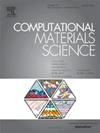反铁磁体CrSBr双分子层的压力诱导磁跃迁和金属化
IF 3.3
3区 材料科学
Q2 MATERIALS SCIENCE, MULTIDISCIPLINARY
引用次数: 0
摘要
近年来,二维材料中相的操纵引起了人们的极大关注。利用第一性原理计算,我们研究了外部垂直压力下CrSBr双分子层的晶体结构、磁性机制和电子性质。我们的研究结果表明,施加压力导致CrSBr双分子层的金属化和磁转变。在低压和高压下Cr-Cr距离的不同行为诱导了从反铁磁态到铁磁态的转变。电子在Cr原子周围的离域,以及S和Br原子杂化的增强,有助于在压力下金属化。铁磁性CrSBr双分子层的带隙关闭发生在3.9 GPa,而反铁磁性CrSBr双分子层的带隙关闭发生在5.0 GPa。此外,施加压力会显著改变面外磁各向异性能量,导致易轴从b轴向c轴移动。这项工作证明了反铁磁CrSBr双分子层的相变控制,表明CrSBr双分子层是设计相关自旋电子器件的有希望的候选材料。本文章由计算机程序翻译,如有差异,请以英文原文为准。

Pressure induced magnetic transition and metallization in antiferromagnet CrSBr bilayer
The manipulation of phases in two-dimensional materials has garnered significant attention in recent years. Utilizing first-principles calculations, we investigate the crystal structures, magnetic mechanism, and electronic properties of the CrSBr bilayer in the presence of external vertical pressure. Our results demonstrate that the application of pressure leads to metallization and magnetic transition in the CrSBr bilayer. The distinct behaviors of Cr–Cr distance at low- and high-pressure induce a transition from an antiferromagnetic to a ferromagnetic state. The delocalization of electrons around Cr atoms, along with the enhanced hybridization of S and Br atoms, contributes to the metallization under pressure. The bandgap closure of the ferromagnetic CrSBr bilayer takes place at 3.9 GPa, while that of the antiferromagnetic CrSBr bilayer takes place at 5.0 GPa. Furthermore, applying pressure will markedly alter the out-of-plane magnetic anisotropy energy, resulting in a shift of the easy axis from the axis to the axis. This work demonstrates the control of phase transitions in the antiferromagnetic CrSBr bilayer, indicating CrSBr bilayer is a promising candidate for designing related spintronic devices.
求助全文
通过发布文献求助,成功后即可免费获取论文全文。
去求助
来源期刊

Computational Materials Science
工程技术-材料科学:综合
CiteScore
6.50
自引率
6.10%
发文量
665
审稿时长
26 days
期刊介绍:
The goal of Computational Materials Science is to report on results that provide new or unique insights into, or significantly expand our understanding of, the properties of materials or phenomena associated with their design, synthesis, processing, characterization, and utilization. To be relevant to the journal, the results should be applied or applicable to specific material systems that are discussed within the submission.
 求助内容:
求助内容: 应助结果提醒方式:
应助结果提醒方式:


